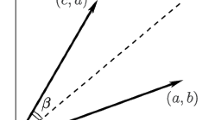Abstract
Let Ω n denote the set of alln×n (1, − 1)-matrices. In 1974 E. T. H. Wang posed the following problems: Is there a decent upper bound for |perA| whenAσΩ n is nonsingular? We recently conjectured that the best possible bound is the permanent of the matrix with exactlyn−1 negative entries in the main diagonal, and affirmed that conjecture by the study of a large class of matrices in Ω n . Here we prove that this conjecture also holds for another large class of (1, −1)-matrices which are all nonsingular. We also give an upper bound for the permanents of a class of matrices in Ω n which are not all regular.
Similar content being viewed by others
References
1.A. R. Kräuter and N. Seifter,On some questions concerning permanents of (1, − 1)-matrices, Isr. J. Math.45(1) (1983), 53–62.
A. R. Kräuter and N. Seifter,Some properties of the permanent of (1, − 1)-matrices, J. Lin. Multilin. Algebra15 (1984), 207–223.
3.H. Perfect,Positive diagnonals of ±1-matrices, Monatsh. Math.77 (1973), 225–240.
4.E. T. H. Wang,On permanents of (1, − 1)-matrices, Isr. J. Math.18 (1974), 353–361.
Author information
Authors and Affiliations
Rights and permissions
About this article
Cite this article
Seifter, N. Upper bounds for permanents of (1, − 1)-matrices. Israel J. Math. 48, 69–78 (1984). https://doi.org/10.1007/BF02760525
Received:
Issue Date:
DOI: https://doi.org/10.1007/BF02760525




